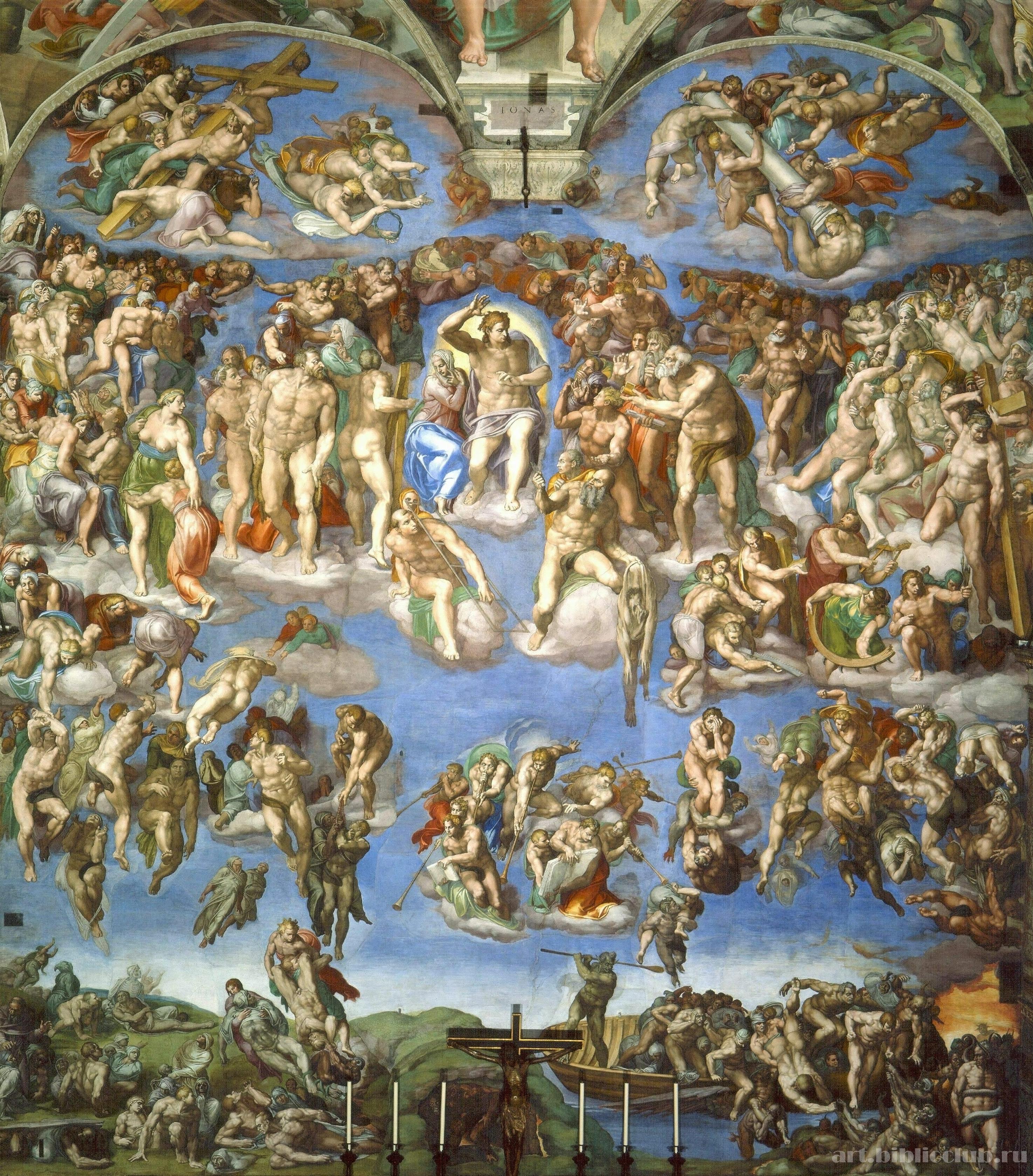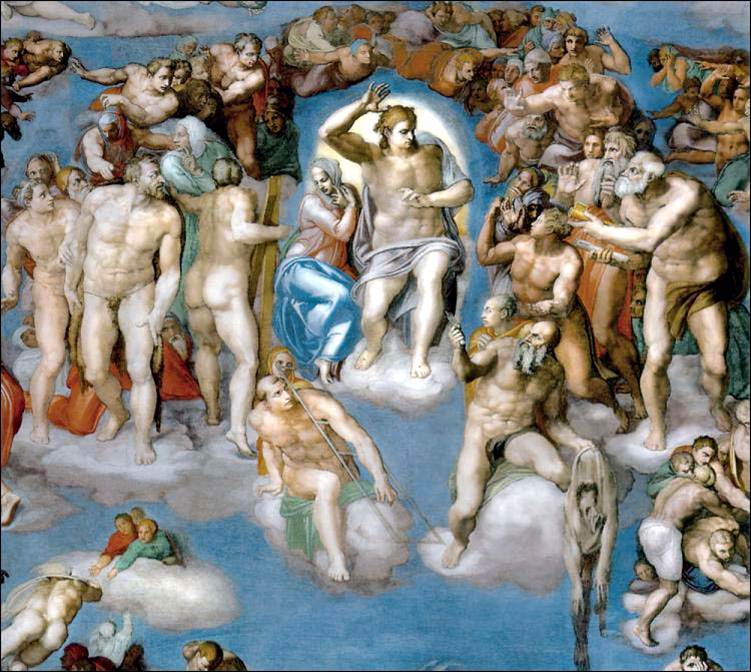On the 500th anniversary of the Protestant Reformation, this series of articles has been looking at how the Church responded to this turbulent age by finding an artistic voice to proclaim Truth through Beauty. This column looks at how art was designed to confront challenges raised by the Reformation with the soothing and persuasive voice of art, and ends here, with the Last Judgment.
Michelangelo’s Last Judgment painting in the Sistine chapel was so tremendous that it sparked controversy from the moment of its unveiling on October 31, 1541, during vespers of All Saint’s Day (today’s Halloween). His contemporary Nino Sernini, reporting to Cardinal Gonzaga, wrote, “The work is of such beauty that your excellency can imagine that there is no lack of those who condemn it. . . ”

For almost 500 years, the massive fresco has been at the heart of a tug-of-war, some pulling Michelangelo into the Protestant camp (as well as the homosexual, social Darwinist and even the Kabbalah club) while others, ever fewer, have held him firm to the Catholic faith.
Michelangelo was in his late 50s when he started work on this project, and he had seen a great deal of the Church. He was acutely aware of the Church’s need for reform, particularly within the clergy, but he also knew the truth of Church teaching.
This work, inaugurated on the anniversary of Martin Luther’s Wittenberg theses, proclaimed the truth of Church teaching so beautifully it could not but cause controversy. It would assert the responsibilities of the clergy and the importance of intercession, exalt the Virgin Mary and underscore the necessity of cooperation with grace in unforgettable imagery.
Clergy – This ultimate response to the Protestant reformers started by rallying the clergy. Placed over the altar wall instead of the usual entrance/exit door, the Last Judgment occupied a space intended specifically for clergy, as seen by the rood screen that separated them from lay people. The elite, educated members of the papal court would have plenty of time to study it during the extended liturgies.

The bustle of bodies, the focus on Sts. Peter, Andrew, Bartholomew and Lawrence—all early priests and deacons who died in bloody witness to Christ—served as a stern reminder that if Jesus’ handpicked followers were crucified, burned and flayed, something similar might be expected from these bishops and cardinals with their benefices and palaces. Unlike in previous versions of this scene, Michelangelo did not label the typical sins of the damned—lust, usury, murder and gluttony—but indicated only one crime: a figure upside down with keys and a moneybag dangling from his waist: the sale of church offices. The commerce in relics, indulgences, lucrative church positions, and especially Grace was the most direct route for the clergy to damnation. Michelangelo included an interesting figure in the lower left corner, however, tonsured and wearing a religious habit, and another cleric ministers to the dead, so the artist never downplays the role played by the clergy in our salvation.

Intercession – Michelangelo produced a jumble of people instead of the neat divisions of most Last Judgments. Dismissed as appropriate only “for public baths and taverns” by papal master of ceremonies Biagio da Cesena (thereafter immortalized as donkey-eared Midas in the lower right corner), upon closer inspection the fresco reveals that in the chaos of movement there is a whole lot of saving going on. On the lower left, angels battle demons to wrest away one soul while another man, perhaps St. Dominic, pulls up two people by rosary beads. One man is African and the other Caucasian, illustrating a Church that has always believed that all souls matter. Many of the people actively helping others into Heaven are not identifiable, perhaps friends, relatives or souls in purgatory who received prayers, now coming to assist the newly resurrected. No artist had ever showed such a community in active welcome of the saved, nor such a joyous reception into Heaven: people embrace, chatter and reach out to welcome the numerous guests.

Mary – Michelangelo painted Christ like no other in the history of art – his powerful physique and distant expression make Him appear unapproachable. His turned face and raised hand seem to sweep all away before him but He does have one vulnerable area, the wound in His side, where Michelangelo painted Mary, Mother of God and the embodiment of the Church.

Never before had Mary been depicted intimately nestled by Jesus—she resembles Eve in the center of the ceiling, emerging from the side of the New Adam. For years my art history teachers explained that she turned away out of fear of her Son, but seriously, what Jewish mother fears her son? Furthermore, how could the mother of Him who is Love, whom He assumed bodily into heaven, not know His true nature?
Mary turns to gaze upon the elect with the same expression used by every painter from Fra Angelico to Botticelli, who illustrated her response “Behold the handmaid of the Lord; be it unto me according to thy word” (Lk 1:38).
That fiat of Mary, her unwavering yes to God, earned her the highest power of intercession, still able to draw souls to her Son on the last day. Mary’s faithful trust embodies Christ’s bride, the Catholic Church and the most direct means to Heaven.
Mary was modeled after a statue of Aphrodite, the Greek goddess of love, and her position next to Christ’s body suggests the love of the bridegroom for his bride, the Church. In recognizing the role of Mary in salvation, the viewer begins to see that the fresco is not as doomsday as it appears – Jesus’ hand frames his wound to draw souls to Him. Indeed almost everyone in the work is saved, and apparently there are no women in Michelangelo’s Hell (unfortunately, one cannot take this artistic expression as dogmatic truth).
Cooperation – The most alarming aspect of the work for contemporaries was the proliferation of nude bodies. Not the newly resurrected or the damned – they had always been represented naked as a kind of reminder of their bareness before God’s judgment and the physical suffering experienced in Hell.
No, it was the saints and martyrs parading in the heroic nudity of antiquity that shocked uninformed viewers. The heavenly elect were always clothed – in Giotto’s version, in Fra Angelico’s and even Signorelli’s famous chapel in Orvieto. Michelangelo chose not to swathe the saints in draperies, but to gift them with trophy bodies, those of the athletes who had, in the words of St. Paul, “run so as to win.”
“Every athlete exercises discipline in every way,” Paul had said. “They do it to win a perishable crown, but we an imperishable one” (1Corinthians 9:24-25).
It takes strength and courage to pursue Truth. Standing before the revealed Truth of Christ is awe-inspiring and fearsome, just as facing the truth about ourselves can be painful and discouraging. These saints, probably physically smaller than most of us, became larger than life by seeking and bearing witness to Truth. There is no room for spiritual pettiness in Michelangelo’s heaven.

Last seen eating locusts in the desert, John the Baptist now looks like Mr. Universe; St. Peter shines as an amazingly well-preserved 70-year-old; even women such as Perpetua and Felicity show that in the race to Heaven the fortitude of the fairer sex equals that of their male counterparts. Each one of the saints used his or her body, through mortification or mortal sacrifice, for the glory of God, and thus their resurrected bodies become all the more magnificent for it. These holy heroes and athletes, men and women alike, were meant to be inspirational images not unlike the pictures we cut out of a magazine to motivate ourselves to a new hairdo, a challenging recipe or a diet.
The first outcry over the painting was over the nudity, disturbing to some of the more hard-core reformers like Pope Paul IV who called it “a stew of nudes.” Thanks to the printing press, Michelangelo’s bodies eventually became less of a clarion call to glory, and more a symbol of an alleged hypocrisy of the Church that wanted to control other people’s passions, but couldn’t control its own. The Church staved off the destruction of the painting when the Council of Trent ordered the covering of the most “offensive” figures, but today, the powerful voice has lost some of its resonance.
As we look to the next centuries, perhaps it is time to recover some of the beautiful impetus given by this image, to proclaim our belief that we are destined to stand in glory with Christ at the end of days thanks to His salvific sacrifice, but also rejoicing in our own cooperation with that gift, following the examples of the saints and bolstered by the prayers of our community, and guided by Mary, Mother of the Church, to Heaven.

